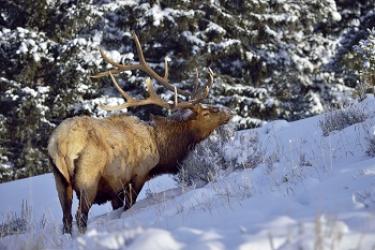Elk Habitat
Elk depend on forest and edge habitat where they can find plentiful grasses, leaves, plants and bark. They are primarily grazers, as opposed to deer and moose, which are generally browsers. But they eat plants and small trees as well—with a special love for aspen sprouts that rise in the spring. In the late fall, elk in mountainous areas migrate to lower elevations to find food, and in spring they return to higher elevations, following the retreating snow that reveals new plant growth.
Elk thrive in young or disturbed forests, which, after a burn or thinning, have an abundance of new plant life budding from increased light on the forest floor. They eat many varieties of plants, from huckleberry, maple and salmonberry to forbs and grasses, tree bark and even twigs during the winter. But closed canopy forests are also important for cover and for forage in late summer. Ideal elk habitat includes open forests and meadows, interspersed with closed- canopy forests.
Elk populations can be found in Washington, Oregon, California, Montana, Idaho, Wyoming, Nevada, Colorado, Utah, Arizona and New Mexico along with smaller numbers in some midwestern states.
How can I get more tips?
It’s simple! Enter your email below.

